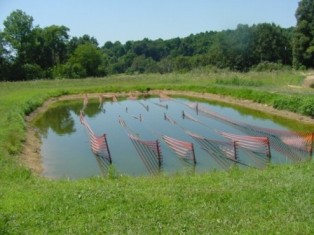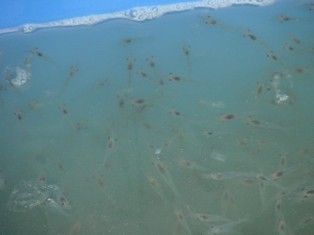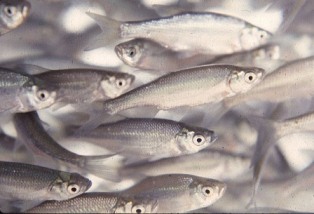Laura Tiu, Aquaculture Specialist, Ohio State University South Centers

What are freshwater prawns?
Freshwater prawn culture is becoming increasingly popular in southern and temperate regions in the United States. The freshwater prawn, sometimes called the freshwater shrimp, is a member of a large group of freshwater crustaceans found in many parts of the world. Most aquaculture efforts have concentrated on the Giant Malaysian Prawn, Macrobrachium rosenbergii, which is a native of southern Asia. Culture efforts in the U.S. were initiated in Hawaii in the 1960s, South Carolina in the 1970s, Mississippi in the 1980s, and Kentucky in the 1990s. Despite these efforts, substantial concentrated production of this species has not developed. However, over the past 10 years, interest in production of this animal has again increased due to increasing demand for local foods, reduced supplies of prawns (especially large sizes), and increases in production rates for prawns based on new management and production practices. Other factors increasing interest in production include suitability for small farm operations, short growing season (<125 days), identified markets for live and fresh prawns in inland locations, the growing trend among consumers wanting to know where and how their food is produced, and the discovery that prawns actually grow more rapidly at cooler temperatures.
Research on temperate culture of freshwater prawns in the U.S. was initiated at Kentucky State University in 1990, and the results have led to the establishment of several freshwater prawn operations in Kentucky, Tennessee, Ohio, West Virginia, North Carolina, Virginia, and Indiana. Freshwater prawns are believed to have great potential for diversification on many farms. They have a short growing season (June 1st to September 15th) that fits in well with other farm activities, requires little labor (20 minutes/day feeding and one long harvest day), and occupies underutilized existing water resources.
What kind of pond do I need to grow freshwater prawns?
Freshwater prawns are grown in earthen ponds as small as one-tenth of an acre to as large as 5+ acres. The ponds must be free of any existing fish/amphibians/turtles, or the prawn juveniles become expensive food for

predators. Edges should be deep to limit wading birds and easy access by other predators. Ponds are built to be both drainable and seinable (harvestable by long nets). Ponds built with internal or external harvesting basins are easiest to harvest, especially from external basins. Newly dug ponds typically have low production for the first few years. Well-established ponds (more than two years of production) are able to support higher levels of supplemental food sources (algae, insect larvae, planktonic animals) as nutrients become “stored” in the pond bottom soils. To achieve maximum production, research and on-farm demonstrations indicate prawns require natural food sources in addition to commercially available sinking pelleted food. Future investigations on increased fertilizer applications in newer ponds to stimulate production of these additional food sources will be needed.
Is an external harvest basin good?
A well-constructed pond will allow almost the entire prawn population to be drained through a pipe of sufficient size into an external harvest basin. This minimizes the harvest labor and makes labor available for rinsing, purging, and maintaining the harvest product quality on ice. A high percentage of the harvested population will be discharged with the last 10 to 20% of the drained water.
Can I grow freshwater prawns in tanks?
Freshwater prawns are not yet being produced economically in tanks, although several producers are trying this method. The prawns are extremely territorial and cannibalistic, resulting in poor survival in tanks. We do not currently recommend this method of culture.
What about water quality?
Water quality is very important in prawn ponds. To maintain appropriate dissolved oxygen levels, the ponds should be aerated 24 hours a day, seven days a week during the culture period. Other water quality parameters, such as temperature, pH, alkalinity, and hardness, should also be monitored. Pond water pH levels can be very critical to successful prawn culture, as it has been demonstrated that pH > 10 may cause significant mortalities. Decreasing pond pH can be achieved by limiting algal removal of carbon dioxide by decreasing pond productivity with aquatic dyes and by addition of carbohydrate (cracked corn). Pre-season applications of organic fertilizers such as soybean or alfalfa meal can also help maintain a safer pH (< 9) for juvenile prawns.
Where do I get the prawns?
Prawn juveniles are purchased from freshwater prawn hatcheries for around 10 cents each (2011 prices). Cost per prawn varies depending on number ordered and delivery method. There are hatcheries in Kentucky, Texas, and Mississippi. Some hatcheries will deliver prawns ordered in sufficient quantity, while others are shipped by air.
How many do I stock?

Stocking densities from 12,000 to 24,000 prawns/acre are recommended depending on the size of prawns desired at harvest and intensity of production methods. Lower densities yield the largest prawns.
What do I feed the prawns?
Prawns need to be fed a pelleted feed. Prawns are fed sinking fish food with 32 to 38% protein. Prawns are typically fed twice a day, with some farmers preferring to feed at dusk since prawns are nocturnal animals.
What is the potential profit?
Budgets developed at the Kentucky State University use breakeven prices of about $5 to $9 per pound depending on survival percentage and initial stocking density, so resulting profits would depend largely on the price per pound that the grower can receive. If a farmer produced 700 pounds per acre at a cost of $7 per pound and received $10 per pound selling from the pond bank, estimated profits for a 1-acre pond would be $2,100. (Dasgupta 2005). Although profits are sometimes higher than this, one must be aware that some ponds have had zero production, resulting in financial losses. Careful business planning is recommended, and updated budgets that address new feed prices and management practices would be needed to determine current profitability and production levels.
How do I market the prawns?

Prawns may typically be sold live or whole on ice, but this should be verified with your state’s authorities. Prawns must be processed in a HACCP-certified facility in order to sell as a processed product off the farm to restaurants or other wholesalers or retailers. Prawns can be sold live for $4.00 to $12.00 per pound depending on the demand in your area and the volume that you are trying to sell. Prawns are sold at festivals, farmers markets, pond-side, restaurants, ethnic markets, and as bait.
What kind of permit do I need to raise prawns?
Each state has different requirements for aquaculture permitting. Contact your local Cooperative Extension office to find out which permitting agencies will apply for raising freshwater prawns in your state.
edited by:
Brian Nerrie, Extension Specialist, Aquaculture, Virginia State University
Robert Durborow, State Extension Specialist for Aquaculture, Kentucky State University
Prawn publications
Biology and Life History of Freshwater Prawns
Culture of Freshwater Prawns in Temperate Climates, Management Practices, and Economics
Freshwater Prawn Farming, Global Status, Recent Research, and a Glance at the Future (2005)
Freshwater Prawn Culture in Kentucky
Pond Production of the Freshwater Prawn in Temperate Climates
Economics of Freshwater Prawn Farming in the United States
